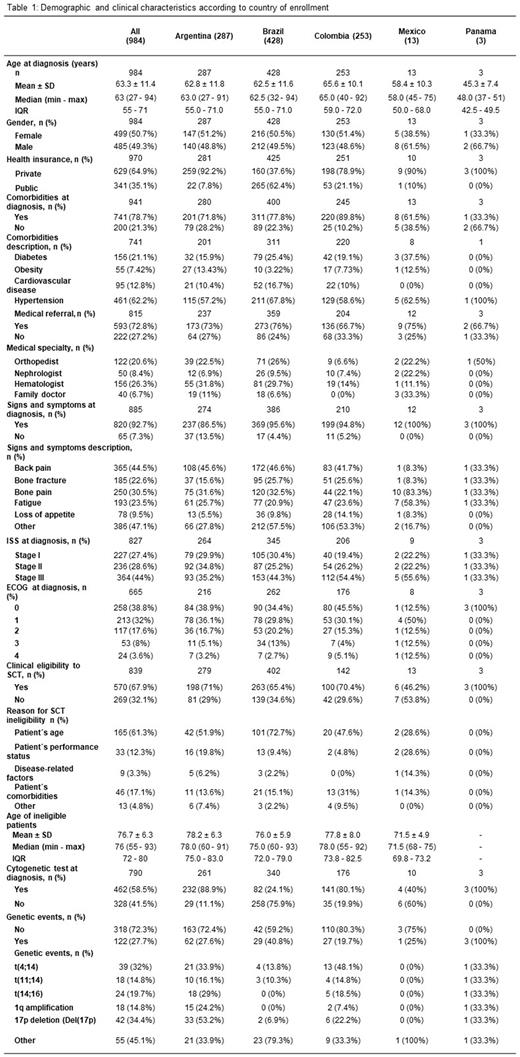Abstract
Background: Multiple myeloma (MM) is characterized by uncontrolled proliferation of plasma cells. This condition accounts for 1% of all cancers and 13% of all hematologic malignancies (HMs). In Latin America there is a relative paucity of real-world data of MM patients. Therefore, the objective of this study is to describe the demographic and clinical characteristics of multiple myeloma patients in Latin America.
Methods: This is an ongoing, noninterventional, multicenter, registry study. Patients diagnosed with MM between 01 January 2016 and 30 June 2021, age ≥ 18 years were enrolled and will be followed until death or the end of study (set for 30 June 2022). For this interim analysis the demographic and clinical data of MM patients in a real-world setting in five Latin American countries, Argentina, Brazil, Mexico, Colombia, and Panama, were assessed. The retrospective data are being abstracted from patient's medical records. All statistical analyses were descriptive.
Results: From a total of 1076 enrolled patients, 984 were assessed (Argentina= 287; Brazil= 428; Colombia= 253; Mexico= 13; Panama= 3). 64.9% of the patients have private insurance coverage, and 35.1% belongs to the public treatment system. The median age at diagnosis was 63 years and a similar distribution between male (49.3%) and female (50.7%) was observed. The majority of the patients (78.7%) presented at least one comorbidity, with hypertension (62.2%) and diabetes (21.1%) the most common medical conditions observed. Around 32% of the patients were considered clinically non-eligible to autologous stem-cell transplantation (ASCT, intention to treat), and advanced age was the main reported reason (median 76 years for non-eligible). Back pain and bone pain were the most frequently reported symptoms at diagnosis by 44.5% and 30.5% of the patients, respectively. Consequently, many patients were referred by orthopedists (20.6%). At diagnosis, the distribution of ECOG status was 0= 38.8%, 1= 32%, 2= 17.6%, 3= 8% and 4= 3.6%; and the ISS 1= 27.4%, 2= 28.6% and 3= 44%. Among the population with a cytogenetic test performed (n=462), only 27.7% were positive for any alteration. The most frequent alterations observed were t(4;14) translocation and del(17p), affecting 39 and 42 patients, respectively. In Table 1 are the clinical and demographic characteristics according to country of enrollment.
Conclusion: These results are a portrait of multiple myeloma in Latin America, showing that patient's characteristics are quite similar among the participating countries. Although the majority of the MM patients in Latin America receive the treatment in the public institutions, in this cohort there were more patients came from private institutions. The most common symptom reported at diagnosis was associated with bone disease and the majority of the patients presented advanced disease (ISS 3 = 44%). Only 32% was considered non-eligible for ASCT at diagnosis. It is worth noting that most of the patients did not present any genetic alterations, which may impact in the identification of higher risk disease.
Disclosures
Hungria:Janssen: Honoraria; GSK: Honoraria; Sanofi: Honoraria; Pfizer: Honoraria; Amgen: Honoraria; Bristol Myers Squibb: Honoraria; Takeda: Honoraria. Trufelli:Janssen Cilag: Current Employment. Saes:Janssen Cilag: Current Employment. Bittencourt:Takeda: Membership on an entity's Board of Directors or advisory committees.
Author notes
Asterisk with author names denotes non-ASH members.


